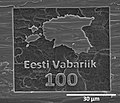| 100th Anniversary of the Estonian Republic Eesti Vabariik 100 | |
|---|---|
 Official logo | |
| Dates | April 2017-February 2020 |
| Location(s) | |
| Website | https://www.ev100.ee/en |
The 100th Anniversary of the Estonian Republic (or more commonly used Estonia 100; Estonian : Eesti Vabariik 100) is an official government program for the celebration of the Republic of Estonia's 100th anniversary. The official anniversary was marked on 24 February 2018, while related celebrations and events took place from April 2017 to February 2020. [1]

